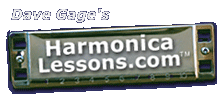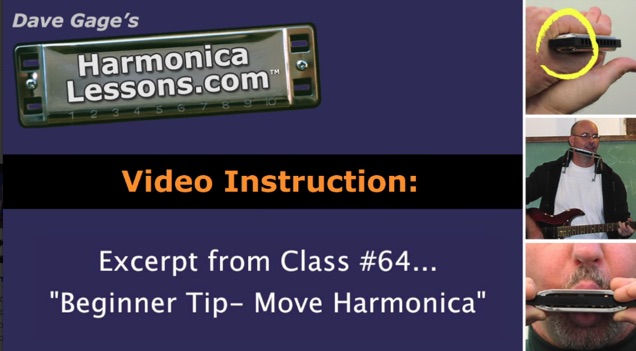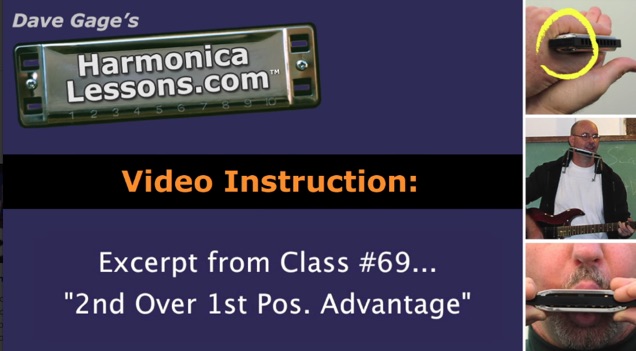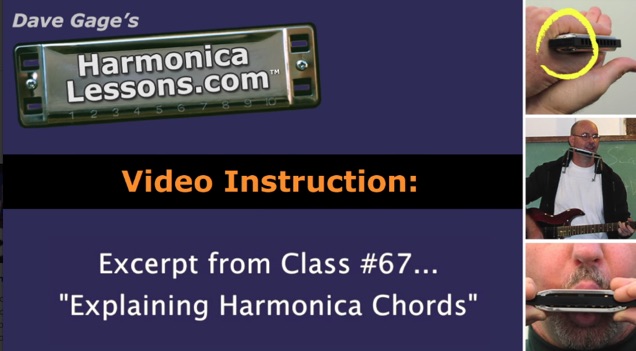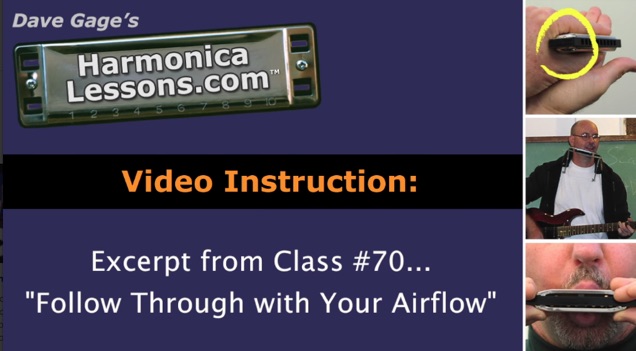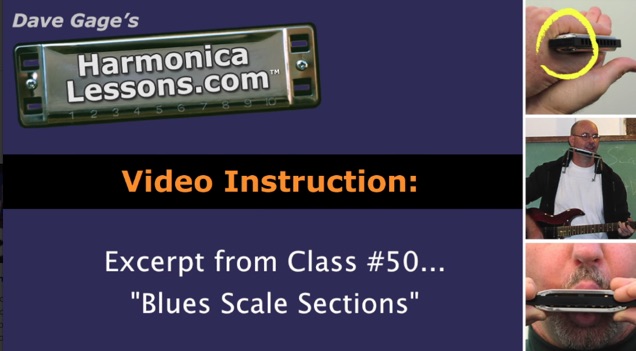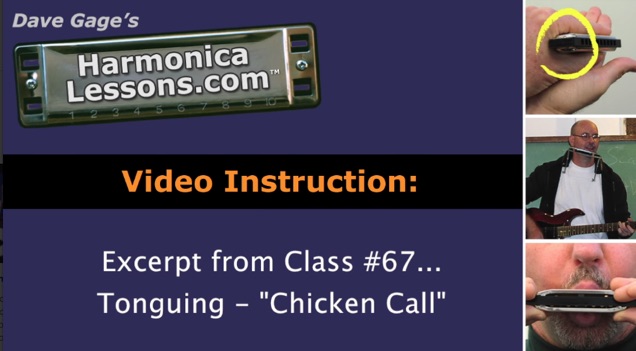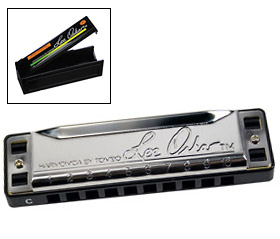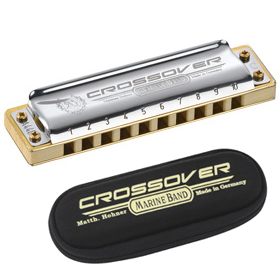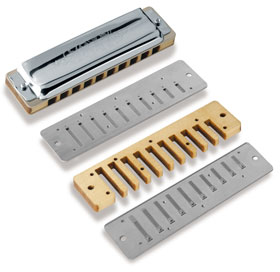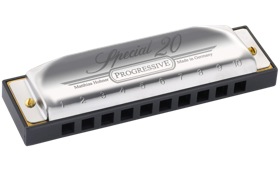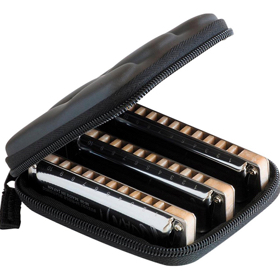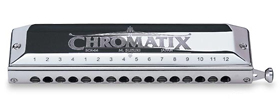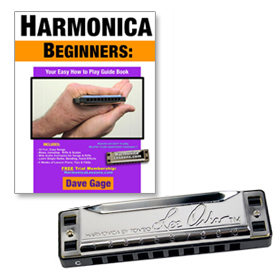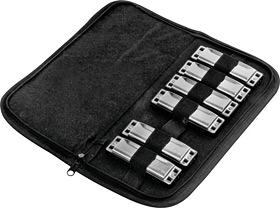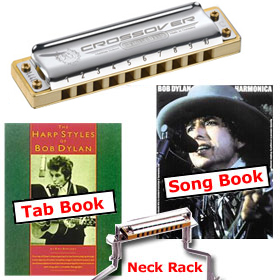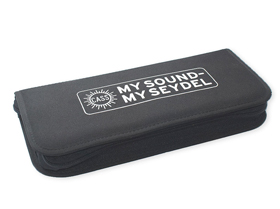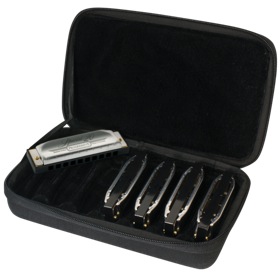Terms & Definitions
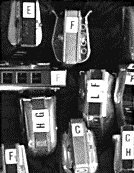 |
SAMPLE PAGES: |
MEMBER-ONLY PAGES:
"G-P" Terms "Q-Z" Terms |
|
- 1st Position- When you play mostly blow notes (usually in the middle portion of the harmonica) on a key of "C" harmonica you will be in the key of "C". This style of playing is called 1st position or "Straight Harp". This is commonly used for simple melodies like "Oh Sussanah" and widely used in a folk context, a la Bob Dylan. Most beginners will start with songs played in the 1st position.
- 2nd Position (cross harp)- When you play mostly draw notes at the low end of the harmonica (holes 1 through 5 draw), you are no longer in the key of the harmonica, but actually in a key which is a perfect 5th (or seven half-steps) up from the key of the harmonica. If you play in 2nd position on a key of "C" harmonica you will now be in the key of "G". This is the way most blues, rock, and country players will use the diatonic harmonica.
- 3rd Position- When you play mostly draw notes in the middle part of the harmonica (holes 4 through 6 draw), you are no longer in the key of the harmonica, but actually in a key which is a major 2nd (or two half-steps) up from the key of the harmonica. If you play in 3rd position on a key of "C" harmonica you will now be in the key of "D" (actually it would be more accurately called "D minor").
3rd position is great for songs in minor keys and can be used in certain blues situations. Your basic starting or ending place (point of resolution) would be the 4 draw hole. The primary emphasis in playing would be the holes 4 through 6 draw. A chart is available on the Positions Chart page for determining the 3rd position key on the 12 different keys of harmonicas. 3rd Position songs page.
- 4th Position- With the 4th position playing style, you are no longer in the key of the harmonica, but actually in a key which is a major 6th (or nine half-steps) up from the key of the harmonica. If you play in 4th position on a key of "C" harmonica you will now be in the key of "A" (actually it would be more accurately called "A minor").
The 4th position is not quite as easy or as useful as the 3rd position or 5th position. It can be used for songs in minor keys and can be used in certain blues situations. Because the basic starting or ending place (point of resolution) would be the 3 draw hole bent down two half-steps, it is very difficult to play in this position and make it consistently sound good. The problem is that your most important note is a bent note that is very hard to always play in tune. For this reason, we recommend the 3rd position and then the 5th position for minor playing.
Occasionally, you will find folk styled players like Bob Dylan, Neil Young, or Bruce Springsteen play in the 4th position. This is because they are playing in a minor key which is the relative minor to the (major) key of the harmonica. This style is very similar to 1st position playing, but your note of resolution (tonic) is the hole 6 draw.
- 5th Position- With the 5th position playing style, you are no longer in the key of the harmonica, but actually in a key which is a major 3rd (or four half-steps) up from the key of the harmonica. If you play in 5th position on a key of "C" harmonica you will now be in the key of "E" (actually it would be more accurately called "E minor"). Although not quite as easy or as common as the 3rd position, 5th position is great for songs in minor keys and can be used in certain blues situations. Your basic starting or ending place (point of resolution) would be the 2 blow hole. A chart is available on the Basic Overview page for determining the 5th position key on the 12 different keys of harmonicas.
- 6th-12th Position- For virtually all beginners and intermediate players, the 6th-12th positions are not useful enough, based on the difficulty of achieving the important notes of the position key, to be included here. The keys of the 6th-12th positions can be determined by using the Circle of Fifths chart and merely continuing past 5th position around the circle.
- 12-Bar Blues- "12-bar blues" is short for a 12-measure (measure is another word for bar) chord progression, which at completion, cycles through and repeats itself as many times as needed for the verses, choruses, and solos in a song. A very high percentage of blues tunes have this as the background for the singing and lead playing. Take a look at the Basic Blues Improv section for a graphical view of 12-bar blues.
- Amp- Short for amplifier. The most common blues harmonica setup for live performances includes a 'bullet mic' and a tube amp. Many different types and brands of amplifiers are available, but the most common amp used by the blues harmonica playing community is the Fender Bassman (typically with 4 ten inch speakers.
- Arpeggio- A chord that is played one note at a time is called an arpeggio.
- "Arrow System"- The "Arrow System" is a type of notation or tablature specifically designed to make playing songs and riffs easy on harmonica. With this system you don't have to know how to read music. The numbers reference the numbered holes on your harmonica and the "up" arrows indicate blow (exhale) notes and the "down" arrows are for the draw (inhale) notes.
- Articulation- Articulation can be used to repeat the same note multiple times (i.e. 4 blow three times in a row) and it can also be used for creating new sounds. Sometimes referred to as "Tonguing". This is done while using the 'whistle method' of playing single notes.
- Bar- A bar of music is the same as a measure of music. Typically, you will have four beats (foot taps) in a bar and then the next bar will begin. Chord progressions are commonly made up of 4, 8, 12, or 16 bars which will then repeat itself or go to a new section.
- Beginner's Shortcut- Added to the top of many pages, the 'Beginner's Shortcut' is a HarmonicaLessons.com convenience for people starting out that don't want or need complete descriptions and detailed explanations of the different techniques and instructions. For those that are more advanced or willing to spend the extra time in the beginning, the full details are available directly below the 'Shortcut'.
- Bending- A technique which allows you to change the actual pitch (lower) of a note. Although bending is done primarily on the draw notes at the low end of the harmonica, there are four types of bending found on a diatonic harmonica.
Bending of notes is not exclusive to the harmonica. This changing of pitch can be done on guitar, saxes, other string instruments, electronic keyboards, and more.
- Blow Bend- Blow bends are typically done on holes 8, 9, and 10 blow on diatonics. Holes 8 and 9 will bend down a half-step while hole 10 blow will bend down a whole step. Blow bends should not be confused with "overblows" which is a completely separate technique.
- Blues Harp (harp)- 1. Slang term for a diatonic harmonica. 2. The Hohner company has a wood-combed diatonic harmonica they have named the "Blues Harp". This particular harmonica is not really any more bluesy than any other diatonic harmonica and is not recommended for players starting out because of the tendency of wooden-combed harmonicas to leak air which makes them difficult to play.
- Blues Scale- Commonly used in blues playing and blues melodies. Musically, the blues scale is a 'minor pentatonic' with a flatted 5th (1-b3-4-b5-5-b7-8).
- Bullet Mic- The most common type of microphone used by harmonica players. It is indeed shaped like a big fat bullet. The most common brands of bullet mics include the Astatic JT30, the Shure Green Bullet, and the Hohner Blues Blaster. Click here for the Mics page for photos, prices, and more information.
- Chicago Blues style- The Chicago Blues style of playing is characterized by the tongue blocking technique as well as by 2nd position playing and an amplified sound (typically the harmonica is played by cupping a "bullet mic" which is then plugged into a tube amplifier like the Fender Bassman).
- Chicago Blues 3rd Position Chromatic Harmonica style- Based on Little Walter's pioneering chromatic harmonica playing, a 16- hole Chromatic harmonica is played in Dm in a way very similar to 3rd position when done on a standard diatonic (emphasis is on the draw notes). With a bullet mic, amp, and effects, this is a very big sound, yet not difficult to play for someone well aquainted with tongue blocking. The slide on the chromatic is virtually never used with this style of play. This type of chromatic playing is typically part of the Chicago Blues sound.
- Chord- Three or more notes played simultaneously. If you took a chord and played the notes one at a time, you would be playing an arpeggio. chords are typically designated in music by using upper case Roman numerals for major chords (i.e. I, IV, and V- the first, fourth, and fifth chords in a key), and by using lower case Roman numerals for minor chords (i.e. ii, iii, and vi- the minor second, minor third, and minor sixth chords in a key).
- Chord Progression (chord changes)- A series of chords (sometimes referred to as the 'chord changes') that constitutes a verse, chorus, or even a complete song. A chord progression can be as short as a 2 bar pattern that repeats throughout a song. More commonly, you will find a 4 bar, 8 bar, 16 bar, or a 12 bar pattern that repeats or is placed together with other progressions to make up a complete song. Most blues follows a standard 12 bar chord progression, but you can run into an 8 or 16 bar blues from time to time. Most songs outside of the blues format will tend be made up of either 8 or 16 bar patterns.
- Chromatic Harmonica- The chromatic harmonica has a button on the side which when not pressed in, allows you to play a normal major scale, and with the button depressed, gives you all the half-steps or notes in between. It is typically used in jazz and classical music, but is found in all styles of music. Bending doesn't work nearly as well on the chromatic as it does on the diatonic harmonica.
- Chromatic Scale- "Chromatic" refers to all 12 different notes which are found in Western culture music. If you start on any key of a piano and play every note, including all white and black keys, you are playing a chromatic scale.
- Circle of Fifths (5ths)- A movement up (or down) of an interval of a perfect 5th (7 half-steps) that when continued, brings you right back to the note (or chord) that you started on.
Positions on the harmonica are based on a circle of 5ths movement. The starting note (or key) would be 1st position, a perfect 5th up would be 2nd position, a perfect 5th up from there would be 3rd position, and so forth. For instance, "C" [1st] to "G" [2nd] to "D" [3rd] to "A" [4th] to "E" [5th] to "B" [6th] to "F#" [7th] to "Db" [8th] to "Ab" [9th] to "Eb" [10th] to "Bb" [11th] to "F" [12th] and back around to "C".
- Comb- This is the piece of plastic, wood, or metal that is sandwiched in the middle of the harmonica by the reed plates and then the cover plates. The reed plates are attached to the comb by numerous small screws (or nails in the case of older type harmonicas like the Hohner Marine Band). Typically, plastic combed harmonicas are easier to play because they tend to leak less air. Wood and metal combed harmonicas will play and sound fine if they have been constructed properly and don't leak much air. For price and playability, we always recommend a good quality plastic combed harmonica for players just starting out.
- Country Scale- Commonly used in blues, country, folk, and pop music for improvisation and melodies. Musically, the country scale is a 'major pentatonic scale' which is all the notes of a major scale except the 4th and 7th ones (1st-2nd-3rd-5th-6th-8th of the major scale).
- Cover Plates- These are the top and bottom metal pieces that are attached to the harmonica comb with a screw/nut on each side. The cover plates protect you from the reeds underneath and vice-versa. They also help focus the sound out the back of the harmonica.
- Cross harp- When you play mostly draw notes at the low end of the harmonica (holes 1 through 5 draw), you are no longer in the key of the harmonica, but actually in a key which is a perfect 5th (or seven half-steps) up from the key of the harmonica. If you play "Cross Harp" (or 2nd position) on a key of "C" harmonica you will now be in the key of "G". This is the way most blues, rock, and country players will use the diatonic harmonica.
- Delayed Tongue- The delayed tongue effect, sometimes referred to as a 'tongue slap', is one of the most distinguishing sounds in blues (especially Chicago blues style). It can also be used in 1st position melody playing. When tongue blocking a single note, you blow the chord first and then quickly slap your tongue on the harmonica. The result is a quickly played chord sound first and then a clean single note.
- Diaphragmatic breathing- The correct way to breathe through the harmonica. The airflow is initiated and moved in both inhale and exhale directions from your diaphragm. Sometimes referred to as "deep breathing", "Zen breathing", "3-step breathing", or "yoga breathing".
- Diatonic Harmonica- The diatonic harmonica doesn't normally have a complete selection of notes like the chromatic harmonica, but many of the notes that are not naturally found on it can be acquired by "bending" certain draw (inhale) and blow (exhale) notes. Most professionals are predominantly diatonic players. It is typically used in blues, rock, country, and folk, but can be found in all styles of music. Sometimes referred to as a "blues harp", "harp", "short harp", or "standard 10-hole".
- Diatonic Scale- A diatonic scale has exactly 7 different notes in it. The last note of a diatonic scale is a repetition of the first note and doesn't count as one of the seven notes. The major scale is the most common example of a diatonic scale. Other types of diatonic scales include: the harmonic minor scale, the natural minor scale, and the melodic minor scale.
- Dorian Mode- The Dorian Mode is not officially a minor scale, but functions as one. It has the same notes as the Major Scale, but you start on the second note of the Major Scale, which becomes your new tonic and starting point. In the key of "C" Major, the Dorian Mode would be "D" Dorian (consisting of D-E-F-G-A-B-C-D). You do not modify any of the original Major Scale notes with sharps or flats, you merely start in a different place.
The scale degrees would consist of 1-2-b3-4-5-6-b7-8 (the eighth note being the same as the first note, up one octave) relative to the Major Scale. When you play in 3rd position you are actually using this Dorian Mode. The Dorian Mode and 3rd Position are commonly used for minor blues and rock.
- Draw note- A note played by inhaling through the harmonica.
- Dropoffs- Dropoffs are just the opposite of slides and are almost always done in a descending direction (down). They are sometimes referred to as "falloffs".
- Dynamics- Varying or contrasting degrees of intensity or loudness. By changing your loud and soft notes, you can make a simple or repetitious phrase much more interesting.
- Enharmonic- One note, or 'pitch', can be referred to in two different ways. When two different notes have different names but are identical in pitch, they are said to be enharmonic. For instance, enharmonic equivalents include: A# and Bb, C# and Db, D# and Eb, E# and F, B and Cb, B# and C, F# and Gb. In most, but not all cases, the notes that have two different names would also be the black keys on the piano.
- "Equal" Tuning (or Equal Temperament tuning)- This refers to the general overall tuning a diatonic or chromatic harmonica has. Each note (or reed) on the harmonica is tuned to the exact mathematically correct pitch it should be with an electronic tuning device. Equal tuning makes for great sounding, in-tune single note, melody playing, and unison playing with other instruments, but the chord playing does not sound as full and rich as with "tempered" tuning (or Just Intonation). The Lee Oskar Major Diatonic and Hohner Golden Melody harmonicas are examples of this type of tuning. Keep in mind, the average player will not likely hear any difference between types of tuning styles for many years.
- "Fake" bending- A type of minimal bend that doesn't create any new notes, just a slight bending effect. This kind of bending is much easier to do than true bends and is the first step towards advanced bending ability. A true or complete bend adds a new note that wasn't previously available.
- Flat- A type of "accidental" that lowers a note by one half-step ("Eb" is one half step below "E").
Didn't find it on this page? Move ahead to our next Terms & Definitions page, Terms "G-P".
